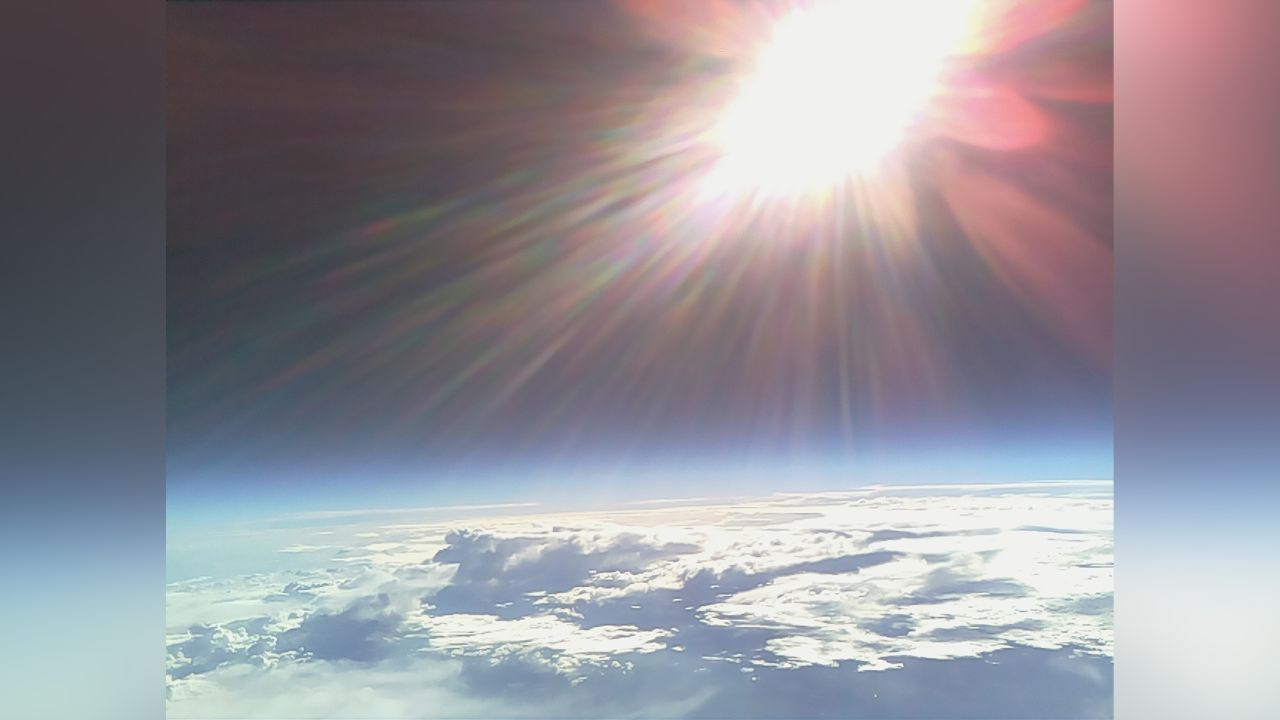(CNN) — Researchers sent giant solar balloons to an altitude of 21,336 meters to record sounds from Earth’s stratosphere, and microphones picked up some unexpected noises.
The stratosphere is the second layer of Earth’s atmosphere, and at its lower level is the ozone layer, which absorbs and scatters ultraviolet radiation from the sun, according to NASA. The thin, dry air in the stratosphere, where jet airplanes and weather balloons reach their highest altitudes, is a relatively quiet atmospheric layer rarely disturbed by turbulence.
Daniel Bowman, principal scientist at Sandia National Laboratory in New Mexico, was inspired to investigate the soundscape of the stratosphere after learning about the low-frequency sounds produced by volcanoes. This phenomenon, called infrasound, is inaudible to the human ear.
The solar-powered hot air balloon from Sandia National Laboratories carries onboard sensors, including a GPS tracker and a reusable infrared sensor. Credit: Sandia National Laboratories
Bowman and his friends had already successfully built their own solar balloon, attaching cameras to weather balloons to “photograph the black sky above and the earth below.”
Bowman proposed installing infrasound recorders on balloons to record the sounds of volcanoes. But then he and his advisor, Jonathan Lees, of the University of North Carolina at Chapel Hill, “realized that no one had tried to bug stratospheric balloons in half a century, so we explored what this new site could do.” explained. Lees Professor of Earth, Marine and Environmental Sciences and Seismology and Volcanology.
Balloons can carry sensors twice as high as commercial aircraft.
“On our solar globes, we have recorded chemical explosions, thunder, crashing ocean waves, propeller planes, city sounds, auxiliary rocket launches, earthquakes, and freight trains and jet planes,” Bowman explains via email. “We have recorded sounds, and its origin is unclear.”
The findings were shared on Thursday 184th Meeting of the Acoustical Society of America, Chicago.
A recording shared by Bowman from a NASA balloon over Antarctica features the introspective sounds of ocean waves sounding like a series of sighs. But other creaks and rattles are of unknown origin.
In the stratosphere, “some aircraft have mysterious infrared signals a few times an hour, but their origin is completely unknown,” Bowman says.
Make solar balloons
Bowman and his collaborators studied balloons from NASA and other aviation providers, but decided to build their own balloons, each about 6 to 7 meters in diameter.
Supplies can be found at hardware and fireworks stores, and balloons can be set up on the basketball court.
“Each balloon is made from painter’s plastic, masking tape and charcoal dust,” Bowman explains via email. “They cost about $50 to make. A two-man team can build one in 3.5 hours. Take it to a field on a sunny day and fill it with air, and it will carry a pound of payload to about 70,000 feet” .
Coal dust is used inside the balloons to darken them, and when the sun shines on the darkened balloons, the air inside them warms up and floats. The cheap and easy-to-make design allows researchers to drop multiple balloons to collect as much data as possible.
This view of one of Sandia National Laboratories’ solar hot air balloons was taken about 21 kilometers above Earth’s surface. Credit: Guide Star Engineering LLC/Sandia National Laboratories
“Basically, a group of high school students who have access to a school gym I can make a solar balloonAnd there’s even a cell phone app called RedVox that can record infrasound,” Bowman said.
Bowman estimates he launched several dozen solar balloons to collect infrasound recordings from 2016 to April of this year. Microbarometers, originally designed to monitor volcanoes, were attached to balloons to record low-frequency sounds.
The researchers tracked their balloons with GPS as they traveled hundreds of kilometers before landing
Inconvenient places.
NASA spent 44 days on the helium balloon, recording data for 19 days before the microphone’s batteries died. Meanwhile, solar balloon flights typically last about 14 hours in the summer, landing as the sun sets.
Unravel the mysterious sounds
The advantage of high-altitude balloons is that noise levels are low, detection range is increased, and the entire Earth is accessible. But the balloons also pose a challenge to researchers. The stratosphere is a harsh environment with severe temperature fluctuations between hot and cold.
“The solar balloons are a bit slow, and we tried to launch them by smashing some into the bushes,” explains Bowman. “We had to go into valleys and mountains to haul our loads. Once, our colleagues from Oklahoma State dropped a balloon in a field, stayed overnight, and relaunched for another full day’s flight.”
Lessons learned from many balloon flights have made the process somewhat easier, but now the biggest challenge for researchers is to find the origin of the signals recorded during the flights.
“There are a lot of planes with signals that we don’t understand the origin of,” Bowman says. “They’re certainly mundane, maybe turbulence, a distant severe storm or some kind of human object like a freight train, but sometimes it’s hard to tell what’s going on because there’s no data.”
Sarah Albert, a geophysicist at Sandia National Laboratories, studied a “sound channel” that carries sounds long distances in the atmosphere at the altitude Bowman studies. theirs records They have caught rocket launchers and other unidentified noises.
Sandia National Laboratories geophysicists (left to right) Daniel Bowman and Sarah Albert show the infrared sensor and the casing used to protect the sensors from extreme temperatures. Credit: Randy Montoya/Sandia National Laboratories
“The sound can get stuck in the channel and reverberate until it’s completely distorted,” Bowman explains. “But it’s still unclear whether it’s close and quiet (like turbulence) or distant and loud (like a distant storm).”
Bowman and Albert will continue to study the airborne sound channel to try to figure out where in the stratosphere the rumbles originate and why some planes record them and others don’t.
Bowman is interested in understanding the soundscape of the stratosphere and unraveling key features such as variation between seasons and locations.
Helium-filled versions of these balloons may one day be used Explore other planets Like Venus, it carries scientific instruments above or within the planet’s clouds for a few days as a test flight for larger and more complex missions.




